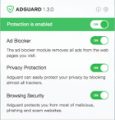If you are reading this blog post, the chances are, you are doing so via the internet browser that has been affected with something named Chumsearch.com hijacker infection. Chumsearch.com is defined as browser hijacker. In most cases it is installed without your permission. It takes control of your browser and changes your newtab, search engine by default and home page to its own. So, you’ll find a new start page and search engine installed in the Safari, Google Chrome and Mozilla Firefox web-browsers.
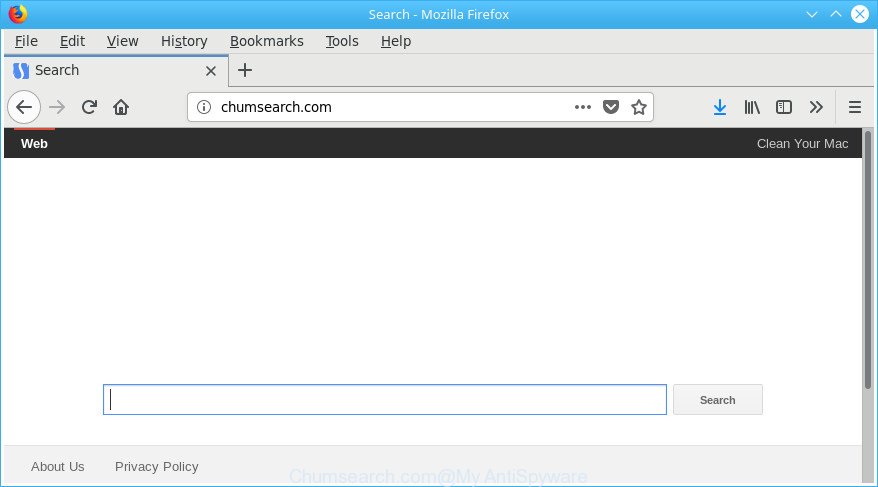
http://chumsearch.com/
In addition, the Chumsearch.com hijacker infection may also change the search provider selected in the internet browser. When you try to search on the affected web browser, you’ll be presented with search results, consisting of ads and Google (or Yahoo, or Bing) search results for your query. Among these search results can occur links that lead to undesired and ad web-sites.
Some hijackers also contain adware (also known as ‘ad-supported’ software) that can open annoying advertisements or gather personal information about you that can be used for marketing purposes. These undesired ads can be shown in the form of pop-unders, pop-ups, in-text advertisements, video advertisements, text links or banners or even massive full page ads. Most of the adware is created to show advertisements, but certain adware is form of spyware that often used to track users to gather a wide variety of confidential data about you.
In order to remove hijacker responsible for redirecting your internet browser to Chumsearch.com website from your machine, clean the infected browsers and revert back the Safari, Firefox and Google Chrome settings to its default state, please use the Chumsearch.com removal guidance below.
Remove Chumsearch.com (removal guide)
The Chumsearch.com is a hijacker infection that you might have difficulty in uninstalling it from your Apple Mac. Luckily, you have found the effective removal instructions in this article. Both the manual removal method and the automatic removal solution will be provided below and you can just select the one that best for you. If you’ve any questions or need assist then type a comment below. Read it once, after doing so, please print this page as you may need to close your internet browser or reboot your Apple Mac.
To remove Chumsearch.com, use the following steps:
- How to manually delete Chumsearch.com
- Chumsearch.com homepage automatic removal
- Stop Chumsearch.com and other annoying webpages
- Tips to prevent Chumsearch.com and other unwanted applications
- To sum up
How to manually delete Chumsearch.com
Steps to remove Chumsearch.com browser hijacker without any programs are presented below. Be sure to carry out the step-by-step tutorial completely to fully remove this unwanted Chumsearch.com .
Delete potentially unwanted programs using the Finder
In order to remove PUPs such as this browser hijacker infection, open the Finder and click on “Applications”. Check the list of installed software. For the ones you do not know, run an Internet search to see if they are ‘ad supported’ software, browser hijacker or PUPs. If yes, delete them off. Even if they are just a software which you do not use, then deleting them off will increase your Apple Mac start up time and speed dramatically.
Make sure you have closed all web-browsers and other applications. Next, delete any unrequested and suspicious programs from MAC using the Finder.
Open Finder and click “Applications”.

Look around the entire list of apps installed on your MAC OS. Most likely, one of them is the hijacker infection that redirects your internet browser to undesired Chumsearch.com page. Choose the questionable program or the application that name is not familiar to you and remove it.
Drag the suspicious program from the Applications folder to the Trash.
Most important, don’t forget, select Finder -> Empty Trash.
Remove Chumsearch.com from Chrome
Like other modern web-browsers, the Chrome has the ability to reset the settings to their default values and thereby recover the web-browser startpage, newtab and default search engine that have been changed by the Chumsearch.com hijacker infection.
First run the Google Chrome. Next, click the button in the form of three horizontal dots (![]() ).
).
It will open the Google Chrome menu. Select More Tools, then press Extensions. Carefully browse through the list of installed plugins. If the list has the extension signed with “Installed by enterprise policy” or “Installed by your administrator”, then complete the following instructions: Remove Chrome extensions installed by enterprise policy.
Open the Chrome menu once again. Further, click the option named “Settings”.
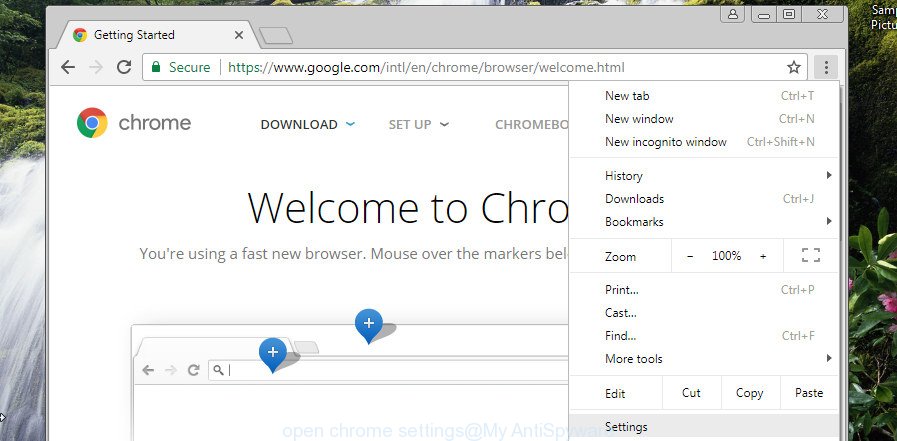
The web-browser will show the settings screen. Another solution to display the Chrome’s settings – type chrome://settings in the internet browser adress bar and press Enter.
Scroll the list of settings to the section that is called Search Engine then On startup. If you see that the settings are grayed out, you are not able to change or select them and the next icon (![]() ) to the right of the settings name (if you hover the mouse pointer over the icon, the message “This setting is enforced by the admin” appears) like shown below.
) to the right of the settings name (if you hover the mouse pointer over the icon, the message “This setting is enforced by the admin” appears) like shown below.

Then you need to do the following: Open System Preferences (on Mac OS), then click Profiles. Look into the AdminPrefs. Hit the minus button to delete malicious profile from your Mac settings.
Open the Chrome settings. Scroll down to the bottom of the page and click the “Advanced” link. Now scroll down until the “Reset” section is visible, as displayed in the following example and click the “Reset settings to their original defaults” button.
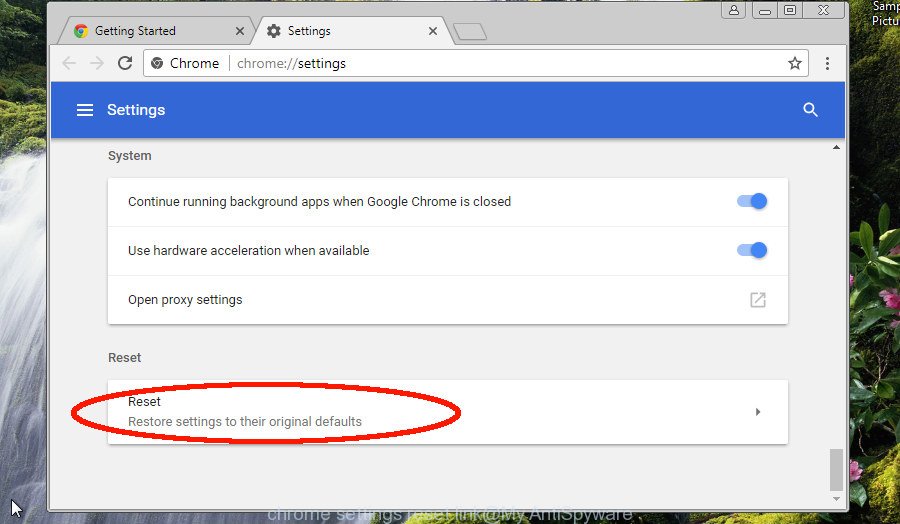
The Chrome will open the confirmation prompt as on the image below.

You need to confirm your action, click the “Reset” button. The browser will start the process of cleaning. When it’s done, the web-browser’s settings including newtab page, search provider by default and homepage back to the values which have been when the Chrome was first installed on your MAC system.
Get rid of Chumsearch.com from Safari
By resetting Safari internet browser you revert back your web browser settings to its default state. This is basic when troubleshooting problems that might have been caused by hijacker infection such as Chumsearch.com.
Click Safari menu and choose “Preferences”.
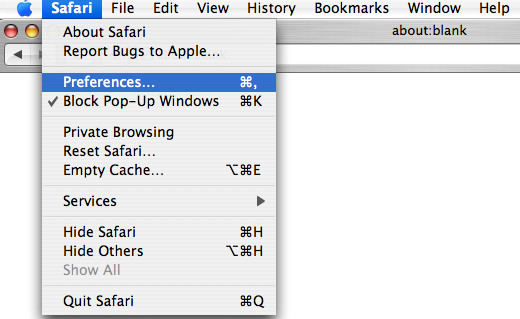
It will open the Safari Preferences window. Next, click the “Extensions” tab. Look for unknown and suspicious plugins on left panel, select it, then click the “Uninstall” button. Most important to get rid of all unknown extensions from Safari.
Once complete, click “General” tab. Change the “Default Search Engine” to Google.
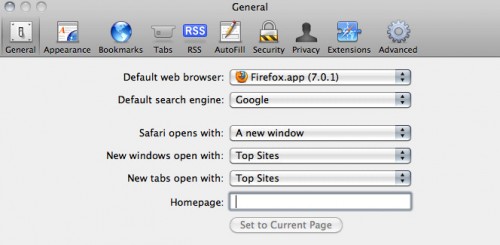
Find the “Homepage” and type into textfield “https://www.google.com”.
Get rid of Chumsearch.com from Mozilla Firefox
Resetting your Mozilla Firefox is good initial troubleshooting step for any issues with your internet browser program, including the redirect to Chumsearch.com web-page. It’ll keep your personal information like browsing history, bookmarks, passwords and web form auto-fill data.
Start the Firefox and click the menu button (it looks like three stacked lines) at the top right of the browser screen. Next, click the question-mark icon at the bottom of the drop-down menu. It will show the slide-out menu.
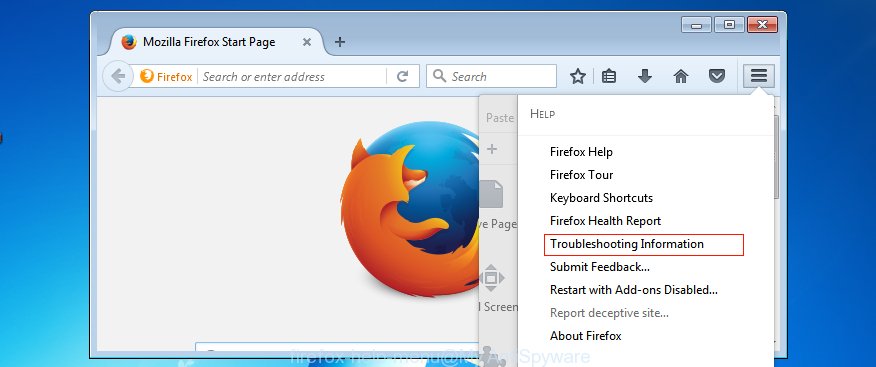
Select the “Troubleshooting information”. If you are unable to access the Help menu, then type “about:support” in your address bar and press Enter. It bring up the “Troubleshooting Information” page as on the image below.
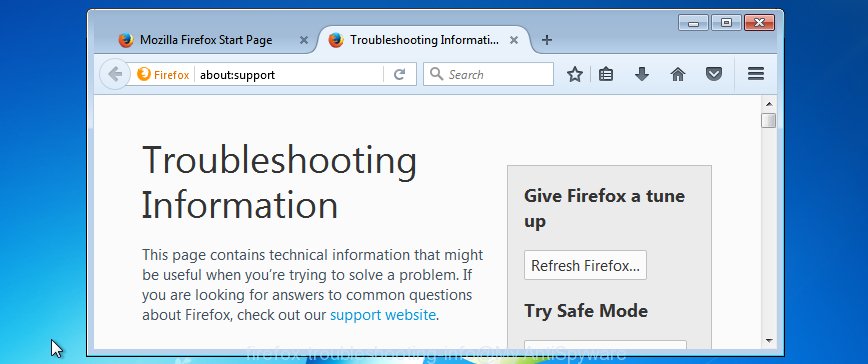
Click the “Refresh Firefox” button at the top right of the Troubleshooting Information page. Select “Refresh Firefox” in the confirmation dialog box. The Firefox will begin a procedure to fix your problems that caused by the browser hijacker infection that causes web-browsers to show unwanted Chumsearch.com webpage. Once, it’s finished, click the “Finish” button.
Chumsearch.com homepage automatic removal
Use malware removal tools to delete Chumsearch.com automatically. The free programs tools specially designed for browser hijacker, ad supported software and other potentially unwanted programs removal. These utilities may get rid of most of hijacker infection from Firefox, Safari and Chrome. Moreover, it can remove all components of Chumsearch.com from system folders and system drives.
How to automatically remove Chumsearch.com with MalwareBytes Anti-Malware (MBAM)
We recommend using the MalwareBytes Free that are completely clean your Apple Mac of the hijacker. The free utility is an advanced malicious software removal application created by (c) Malwarebytes lab. This program uses the world’s most popular antimalware technology. It is able to help you get rid of browser hijacker infections, potentially unwanted programs, malware, adware, toolbars, ransomware and other security threats from your computer for free.
Please go to the following link to download the latest version of MalwareBytes Free for Mac OS.
21024 downloads
Author: Malwarebytes
Category: Security tools
Update: September 10, 2020
After the download is complete, close all applications and windows on your computer. Open a directory in which you saved it. Run the saved file and follow the prompts.
Once install is finished, you will see window as displayed in the figure below.
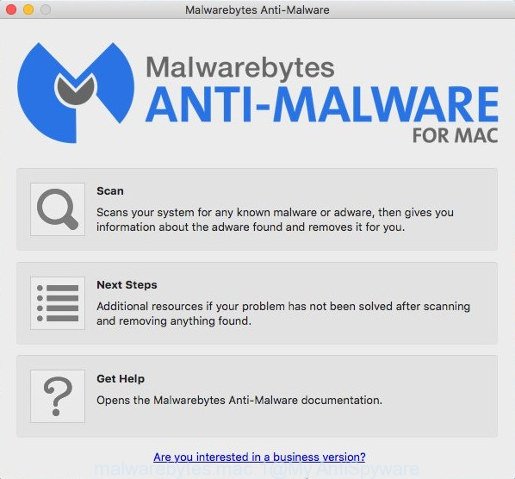
Now press the “Scan” button to perform a system scan with this tool for the hijacker infection which cause Chumsearch.com web site to appear. A system scan can take anywhere from 5 to 30 minutes, depending on your MAC OS. While the MalwareBytes application is checking, you may see how many objects it has identified as threat.

When the system scan is complete, MalwareBytes will show you the results. Review the report and then click “Remove Selected Items” button.
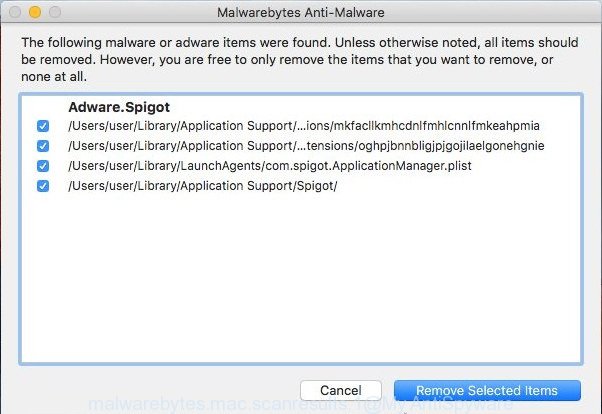
The Malwarebytes will now get rid of hijacker responsible for redirecting user searches to Chumsearch.com and move items to the program’s quarantine.
Stop Chumsearch.com and other annoying webpages
It is important to run ad blocking software like AdGuard to protect your MAC OS from malicious web-sites. Most security experts says that it’s okay to stop advertisements. You should do so just to stay safe! And, of course, the AdGuard can to block Chumsearch.com and other unwanted web sites.
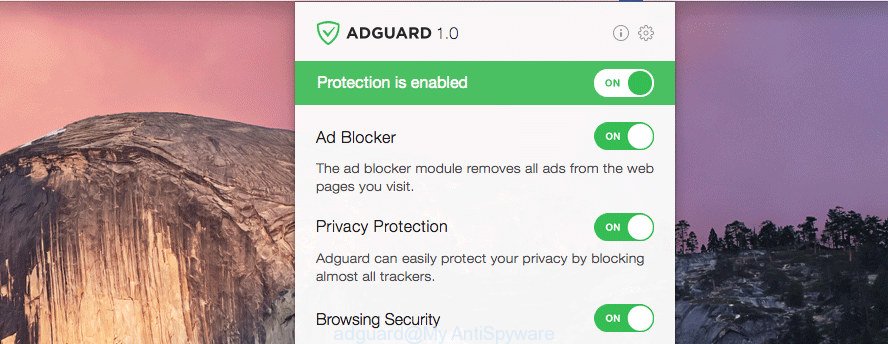
- Click the link below to download the latest version of AdGuard for Mac.
AdGuard for Mac download
3782 downloads
Author: © Adguard
Category: Security tools
Update: January 17, 2018
- Once the downloading process is finished, launch the downloaded file. You will see the “Setup Wizard” program window. Follow the prompts.
- After the installation is done, press “Skip” to close the installation program and use the default settings, or click “Get Started” to see an quick tutorial which will assist you get to know AdGuard better.
- In most cases, the default settings are enough and you don’t need to change anything. Each time, when you run your MAC system, AdGuard will run automatically and stop pop-ups, Chumsearch.com redirect, as well as other harmful or misleading webpages.
Tips to prevent Chumsearch.com and other unwanted applications
Many hijackers like Chumsearch.com are included in the free applications installer. In many cases, a user have a chance to disable all included “offers”, but some installers are designed to confuse the average users, in order to trick them into installing an adware or potentially unwanted apps. Anyway, easier to prevent the browser hijacker infection rather than clean up your MAC system after one. So, keep the internet browser updated (turn on automatic updates), use a good antivirus applications, double check a freeware before you start it (do a google search, scan a downloaded file with VirusTotal), avoid malicious and unknown websites.
To sum up
Now your computer should be free of the browser hijacker infection responsible for redirecting your web browser to Chumsearch.com web-site. We suggest that you keep AdGuard (to help you block unwanted popup advertisements and undesired malicious sites) and MalwareBytes Free (to periodically scan your MAC for new malicious software, browser hijacker infections and adware). Make sure that you have all the Critical Updates recommended for Mac OS. Without regular updates you WILL NOT be protected when new hijackers, malicious applications and ‘ad supported’ software are released.
If you are still having problems while trying to get rid of Chumsearch.com home page from your web browser, then ask for help in our Spyware/Malware removal forum.
Updated, Jun 2018: A step has been added that describes how to remove Chumsearch.com, if it is blocked from removal by “This setting is enforced by the admin”. Quick link.

